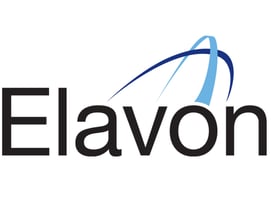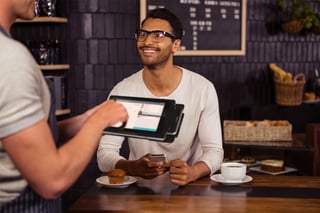 The food & beverage industry has gone through many changes in the last few years. Better technology has enabled restaurant owners to bring the payment process right to the patron with Pay-at-the-Table solutions. A Pay-at-the-Table solution allows servers to bring the payment process right to the patron. Instead of shuttling their credit card back and forth between the diner and the point of sale (POS) system, the servers can use a wireless terminal or an mPOS solution to accept payment right where the diner is. This assures customers that their credit card data is safe as they have complete control over the transaction and allows restaurants to better engage with them.
The food & beverage industry has gone through many changes in the last few years. Better technology has enabled restaurant owners to bring the payment process right to the patron with Pay-at-the-Table solutions. A Pay-at-the-Table solution allows servers to bring the payment process right to the patron. Instead of shuttling their credit card back and forth between the diner and the point of sale (POS) system, the servers can use a wireless terminal or an mPOS solution to accept payment right where the diner is. This assures customers that their credit card data is safe as they have complete control over the transaction and allows restaurants to better engage with them.
To talk more about the Pay-at-the-Table solution and its benefits, we caught up with Eric Liebman, vice president, head of product strategy, travel & leisure at Elavon.
Pay-at-the-Table is starting to become popular in the U.S. What value/benefits does it provide to restaurant owners and patrons?
 Eric Liebman: Pay-at-the-Table has benefits for the restaurant, the server and the customer. It is kind of a “win-win-win,” if you will. The restaurant benefits from higher security around credit card transactions and reduced chargebacks, as all Pay-at-the-Table-capable devices are EMV-enabled. The owner benefits from giving the server more time to focus on customer interaction and turning tables rather than shuttling credit cards around between the table, POS and back to the table again. The servers often see increased tips as the customer experience improves due to the reduced wait time to complete the payment process. In addition, they improve their overall efficiency by reducing their time going back-and-forth between tables and the POS. Servers can also facilitate shared checks more easily with Pay-at-the-Table solutions.
Eric Liebman: Pay-at-the-Table has benefits for the restaurant, the server and the customer. It is kind of a “win-win-win,” if you will. The restaurant benefits from higher security around credit card transactions and reduced chargebacks, as all Pay-at-the-Table-capable devices are EMV-enabled. The owner benefits from giving the server more time to focus on customer interaction and turning tables rather than shuttling credit cards around between the table, POS and back to the table again. The servers often see increased tips as the customer experience improves due to the reduced wait time to complete the payment process. In addition, they improve their overall efficiency by reducing their time going back-and-forth between tables and the POS. Servers can also facilitate shared checks more easily with Pay-at-the-Table solutions.
The customer certainly benefits by having the peace of mind of retaining the possession of their card throughout the process, vastly reducing the risk of having their card cloned. In addition, the checkout process is faster! Rather than waiting to have their card taken away, processed and brought back, they can enter their card right at their tables and input the tip at the same time (saving the restaurant time from having to do after-the-fact tip adjusts all the time).
According to the NRA's 2015 Restaurant Industry Forecast, 79% of consumers said they thought that technology increased convenience, finding that technology is an important aspect of where they choose to eat. Lastly, another benefit to the cardholder is eliminating the risk of “fat fingering” tip amounts, which is where the server enters a larger amount for the tip during the tip-adjust entry.
What are the benefits of implementing a Pay-at-the-Table solution for a restaurant owner?
EL: There are three clear benefits of implementing a Pay-at-the-Table solution to the restaurant owner:
- Reduced chargebacks by using only EMV-enabled smart terminals or mPOS solutions
- Higher table turnover allowing servers to focus on food delivery and customer engagement rather than shuttling credit cards back and forth
- Tips are entered at the time of transaction rather than later as a ‘tip-adjust’ saving the restaurant time and scope of error
How does Pay-at-the-Table affect consumer behavior?
 EL: According to the NRA survey, most customers view new technology favorably and believe it enhances the convenience factor when dining out. In addition, it saves time over the traditional process of flagging down a server for your check, then waiting to receive the folio with the check, then flagging down a server again, then finally waiting to get the check back with the credit card receipt.
EL: According to the NRA survey, most customers view new technology favorably and believe it enhances the convenience factor when dining out. In addition, it saves time over the traditional process of flagging down a server for your check, then waiting to receive the folio with the check, then flagging down a server again, then finally waiting to get the check back with the credit card receipt.
On the flip-side, there will be a learning curve for Pay-at-the-Table. Servers need to be trained to use the solution and help customers use it as well, since they are used to handing their cards to the restaurant staff. So, while this will be a different experience, we anticipate rapid adoption here in the U.S.
How can restaurants looking to get started with Pay-at-the-Table in their businesses define their point of sale (POS) strategy?
EL: The POS selection process is based on a number of attributes. Pay-at-the-Table should not necessarily define the POS strategy, but a restaurant owner needs to ensure that the POS supports Pay-at-the-Table with the full functionality required. A POS that is already cloud-based is also a good starting point, as these systems, by design, already understand remote input and output payment data transmission to/from the POS.
What are some of the common challenges that merchants face when implementing Pay-at-the-Table? How can merchants address these challenges?
EL: First off, the merchants who decide to offer Pay-at-the-Table will likely have to replace their existing payment infrastructure if they do not support the latest payment methods. This is to support both EMV cards and Pay-at-the-Table. Next, customers may be a bit confused when the server brings the payment device to the table rather than collecting the card and bringing it back to the POS. So, there will need to be some education to why they are now bringing the device to the customer. In this case, there needs to be extensive training for the servers so they can easily reassure customers that this is a global process for accepting payments and that it is a safer, more convenient way to pay for their meal.
Other than the Pay-at-the-Table, what are some of the other innovative technologies that you have seen in the restaurant industry?
EL: It is exciting to see the development of a new breed of POS and restaurant apps emerge in the market. We are seeing more and more cloud-based systems with more powerful ‘order-ahead’ capabilities. This means the convenience level for the customer will continue to be improved and ultimately payments will become frictionless. As the restaurant technology gets enhanced each year, it will allow the diner to easily book a table, order food, communicate with the restaurant with special orders and even apply loyalty points – all from your mobile phone or tablet. Think of it as the “Uberization” of the restaurant experience.
Hope you found this blog post useful. Please leave your comment and questions in the comment section below or visit our Ask an Expert page.










